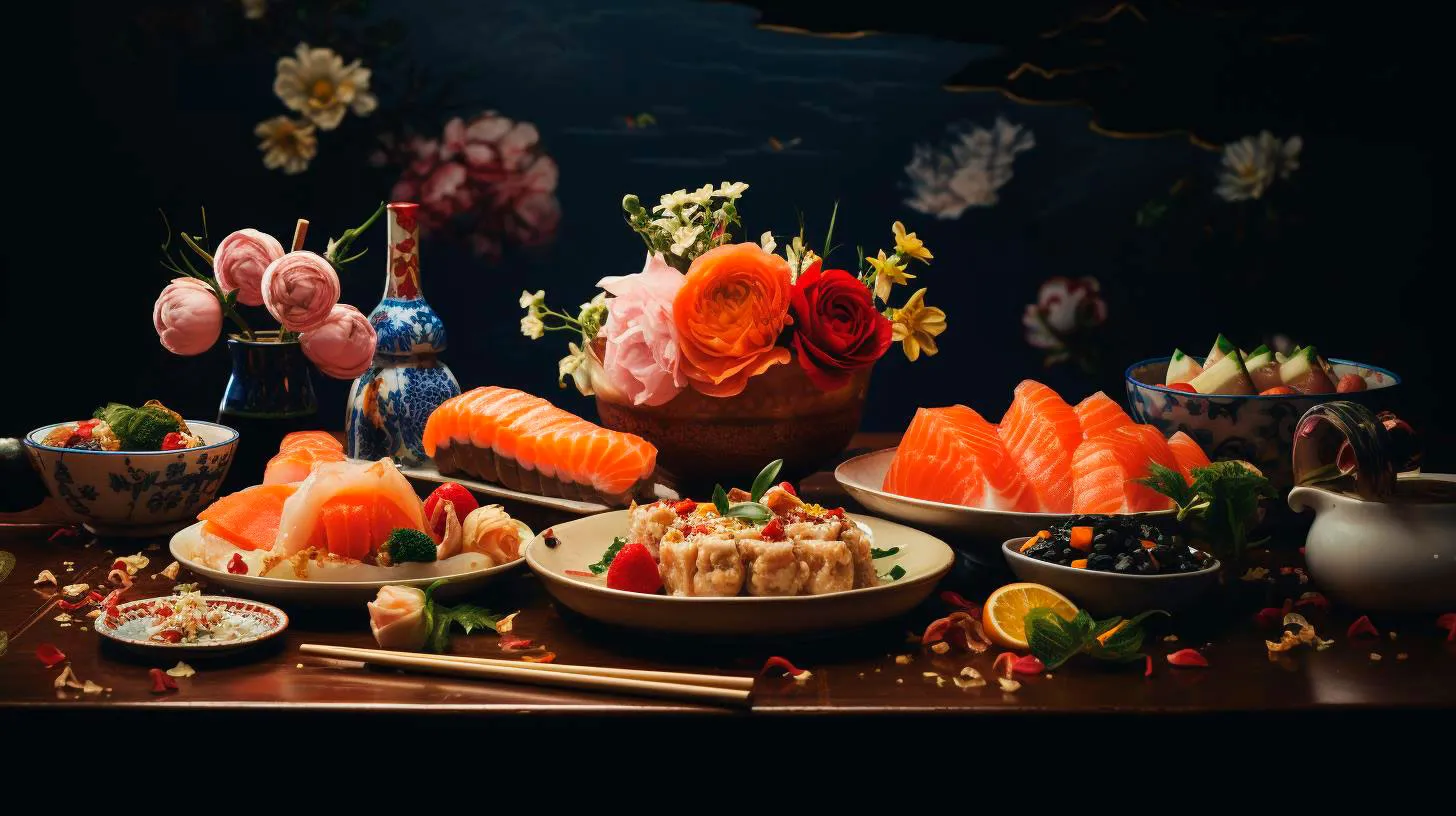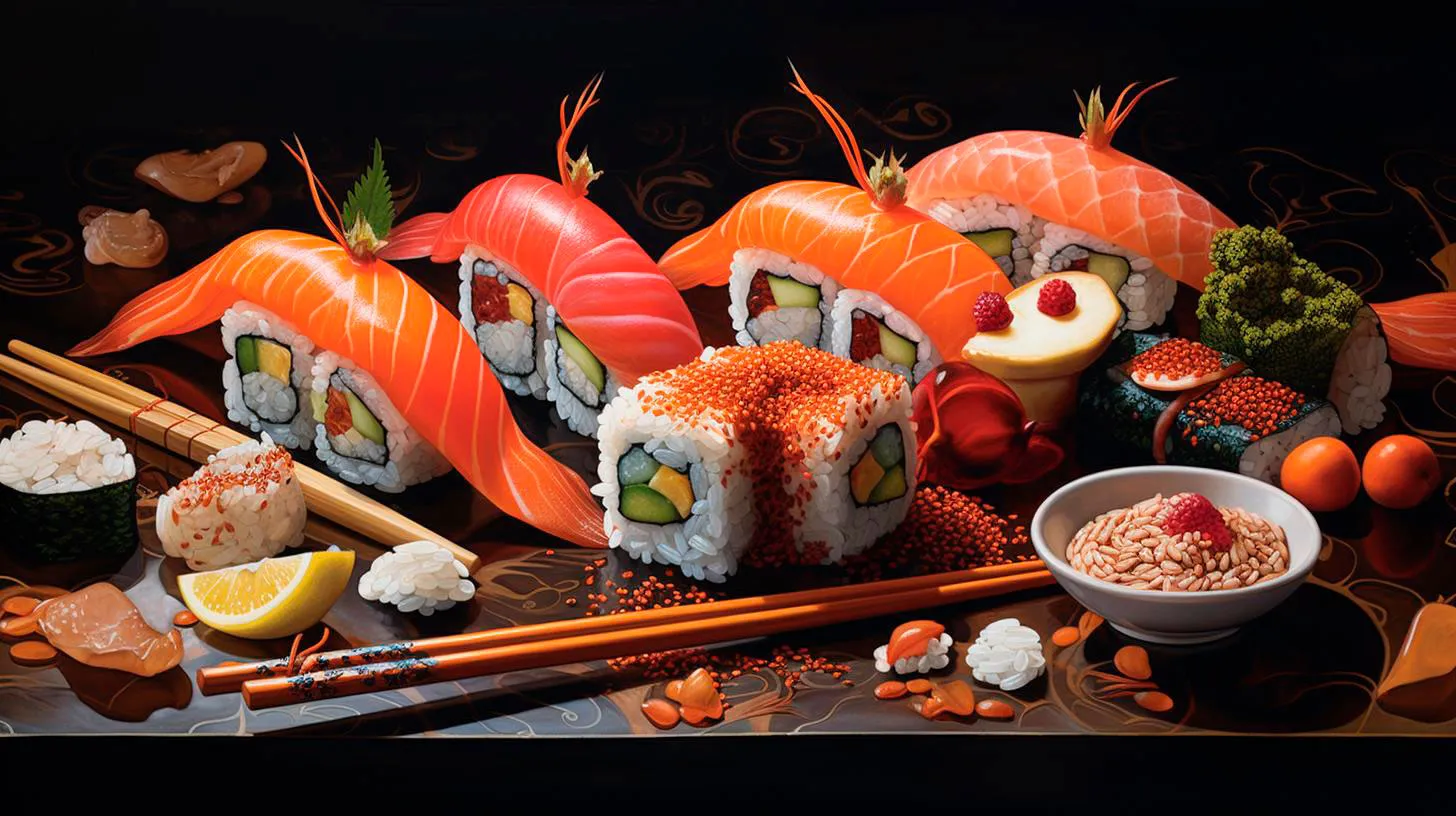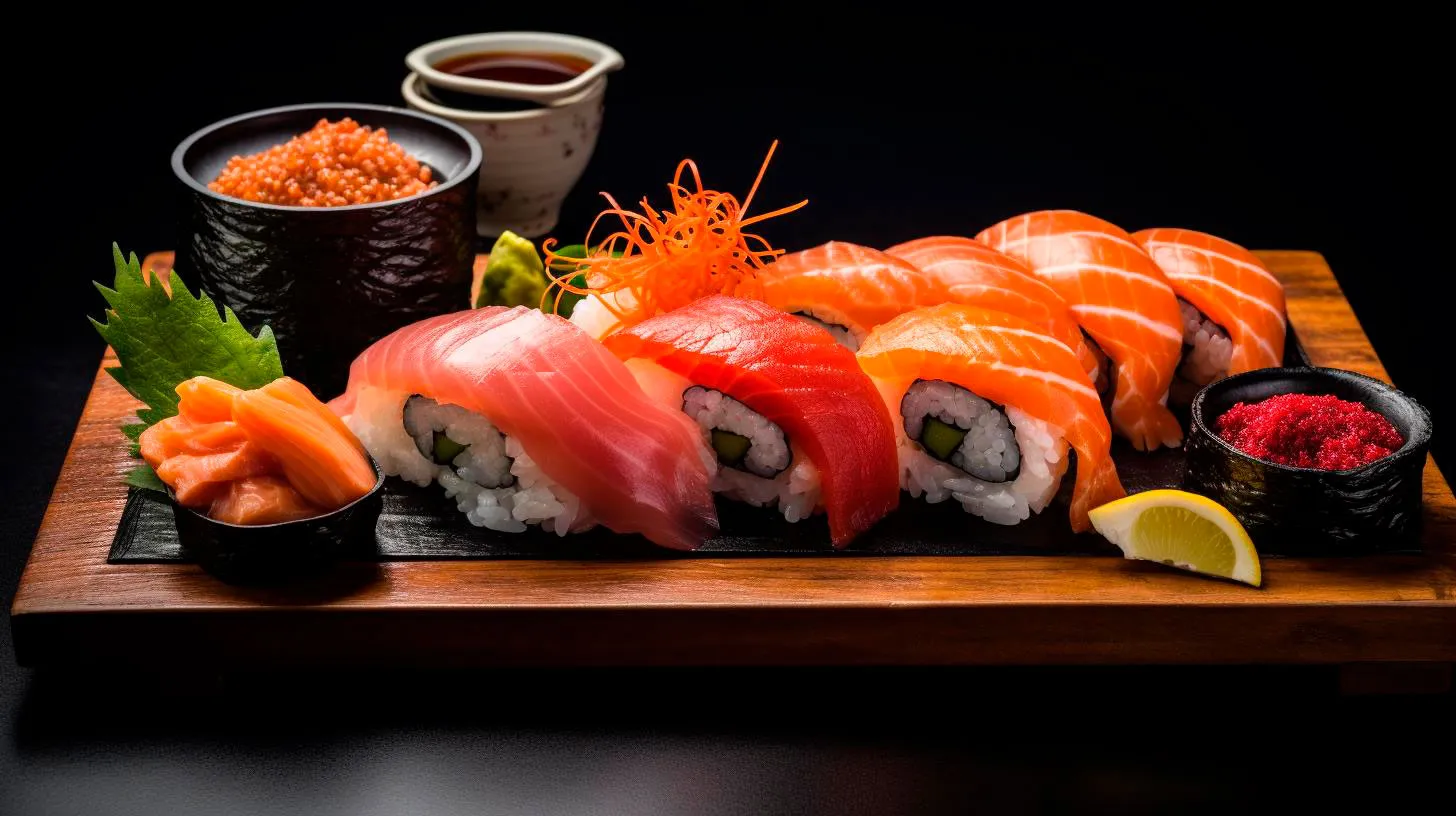From Maki to Nigiri: Exploring the Art of Sushi Making
A Bite of History
Sushi has a rich history dating back to ancient Japan where it originated as a means of preserving fish. Over time, it evolved into a delectable delicacy enjoyed by people of all ages. Today, sushi is not only an integral part of Japanese culture but has also become popular worldwide.
Key Takeaway: Sushi has a long and storied history and has transformed from a preservation technique to an esteemed culinary art form.
The Ingredients
Sushi, at its core, consists of two main elements: rice and fish. However, the art of sushi making goes far beyond these primary ingredients. Here are some key components that make sushi a one-of-a-kind experience:
- Nigiri: This classic sushi variety features a small mound of vinegared rice topped with a slice of fresh fish or seafood. The mild tanginess of the rice beautifully complements the flavors of the fish.
- Maki Rolls: Maki rolls consist of a layer of rice and various ingredients, such as fish, vegetables, or seafood, rolled in a sheet of seaweed called nori. These rolls are then sliced into bite-sized pieces.
- Sashimi: Unlike other sushi varieties, sashimi focuses solely on the raw fish or seafood, skillfully sliced and served without rice.
- Condiments: Soy sauce, wasabi, and pickled ginger are commonly served alongside sushi. They provide a burst of flavors that complement the delicate taste of the sushi.
Key Takeaway: Sushi is not just fish and rice; it encompasses various types, such as nigiri, maki rolls, and sashimi, each with its own unique characteristics.
The Art of Assembly
What sets sushi apart is the artful precision used in its preparation. From the selection of ingredients to the delicate hand movements, every step in the sushi-making process requires skill and expertise. Here’s a glimpse into the meticulous art of assembly:
- Perfectly Cooked Rice: The foundation of sushi lies in the rice. Each grain should be cooked to perfection, tender yet firm, and seasoned with a delicate balance of rice vinegar, sugar, and salt.
- The Fish: The quality and freshness of the fish are of utmost importance. Sushi chefs meticulously select the best cuts, ensuring they are firm, flavorful, and free from any unpleasant smells.
- Knife Skills: Slicing the fish requires precision and mastery of knife techniques. The angle, speed, and pressure applied while cutting contribute to the overall texture and presentation of the sushi.
- Rolling Technique: Creating aesthetically pleasing maki rolls demands dexterity. Chefs delicately layer the rice and other ingredients onto the nori sheet and tightly roll them using a bamboo mat, called a makisu.
Key Takeaway: The art of sushi making involves culinary skills, precise cutting techniques, and an eye for aesthetic presentation.
Sushi Culture and Etiquette
In Japanese culture, sushi is not just a meal; it is a revered experience with its own set of customs and etiquette. Familiarizing yourself with these cultural nuances adds depth to your sushi dining experience:
- Chopstick Etiquette: When eating sushi with chopsticks, it is essential to use them correctly. They should not be crossed, stabbed into the rice, or left standing upright in the soy sauce.
- Wasabi and Soy Sauce: To properly season your sushi, a small amount of wasabi can be mixed into the soy sauce. However, be careful not to overpower the delicate flavors of the fish.
- Savor Each Bite: Sushi is meant to be enjoyed slowly and savored. Take your time and appreciate the intricate flavors and textures as you indulge in each piece.
- Respect the Chef: When dining at a traditional sushi restaurant, it is customary to show respect to the sushi chef. Trust their expertise and allow them to guide you through the culinary journey.
Key Takeaway: Embracing the cultural customs and etiquette of sushi dining enhances the overall experience and respect for the art form.
The Sushi Revolution
As sushi gained international popularity, adaptations and innovations emerged worldwide. Sushi fusion and creative interpretations have given rise to unique flavors and presentations:
- Sushi Burritos: This fusion creation combines the convenience of a burrito with the flavors of sushi. It typically features a large nori wrap filled with rice, fish, and an array of vegetables and sauces.
- Vegetarian Sushi: Catering to diverse dietary preferences, vegetarian sushi varieties use ingredients like avocado, cucumber, tofu, and tempura vegetables.
- Sushi Burgers: With sushi rice acting as the buns, sushi burgers offer a modern twist to traditional sushi. The fillings often include cooked or raw fish, veggies, and unique sauces.
Key Takeaway: The sushi world continues to evolve, infusing flavors from different cuisines and catering to diverse preferences.
From its humble origins as a preservation method to its status as a revered culinary art form, sushi has come a long way. The precise craftsmanship and attention to detail that go into sushi making make it a remarkable gastronomic experience.
So, the next time you indulge in a delicious piece of sushi, take a moment to appreciate the centuries-old tradition and artistry that culminate in that single bite.
Savoring Sushi: A Culinary Journey through Japan’s Culinary Masterpiece
In this article, we will take you on a culinary journey through Japan, exploring the history, artistry, and flavors that make sushi an unforgettable experience.
The History of Sushi
Sushi traces its origins back to ancient Japan, where it was originally created as a means of preserving fish during the fermentation process. Over time, it evolved into a delicacy enjoyed by nobles and eventually spread to the masses. Today, sushi is a symbol of Japanese culinary expertise, blending tradition with innovation.
The Art of Sushi Making
Crafting sushi is an art form in itself, requiring years of dedicated practice and precision. The sushi chef, known as an itamae, skillfully combines fresh ingredients with meticulous knife techniques to create visually appealing and mouthwatering delicacies.
- Key Takeaway: Sushi making is an intricate art that requires precision and skill.
- Advantage: You can observe and appreciate the masterful skills of a sushi chef when dining at traditional sushi bars.
Savoring the Flavors
One of the most intriguing aspects of sushi is its diverse range of flavors. From the delicate and buttery texture of fatty tuna (toro) to the savory richness of grilled eel (unagi), each component has its own unique taste profile. The balance of flavors is further enhanced by the expert combination of vinegared rice, fresh seafood, and accompanying condiments.
- Key Takeaway: Sushi offers a harmonious blend of flavors, allowing you to savor a multitude of tastes in each bite.
- Advantage: You can customize your sushi experience by trying different combinations of fish, vegetables, or condiments.
Sushi Etiquette and Tradition
When indulging in sushi, it is important to observe certain etiquette and traditions to fully appreciate the experience. One common practice is to dip the fish side of the sushi into soy sauce rather than the rice, as the delicate rice can easily become soggy. Additionally, eating sushi with your hands is considered acceptable, allowing you to feel a closer connection with the food.
- Key Takeaway: Understanding sushi etiquette enhances your dining experience and shows respect for Japanese culture.
- Advantage: Embracing sushi etiquette allows you to have a more authentic and immersive culinary journey.
Sushi Beyond Japan: A Global Phenomenon
Over the years, sushi has traversed borders and gained immense popularity worldwide. From Tokyo to New York and Sydney to London, sushi restaurants are now a common sight in many cities across the globe. Japanese expatriates and sushi aficionados have contributed to the spread of this delectable cuisine, ensuring that sushi is accessible to people of different cultures.
Health Benefits of Sushi
Aside from its delightful taste, sushi also offers numerous health benefits. The predominant use of fresh fish in sushi provides an excellent source of omega-3 fatty acids, known to promote heart health and reduce the risk of certain diseases. Furthermore, sushi commonly includes nutrient-rich ingredients like seaweed and vegetables, contributing to a wholesome and well-rounded meal.
- Key Takeaway: Sushi can be a healthy dining choice due to its nutrient-rich components and beneficial fats.
- Advantage: Sushi allows you to enjoy a flavorsome meal while incorporating nutritious elements into your diet.
Sushi: A Divine Gastronomic Journey
The popularity of sushi transcends its role as a mere dish; it is an experience that stimulates all the senses. From the delicate artistry of the presentation to the explosion of flavors in each bite, sushi provides a glimpse into the culinary soul of Japan. Embarking on a sushi journey is akin to embarking on a divine gastronomic adventure that leaves a lasting impression.
So, the next time you savor a piece of sushi, take a moment to appreciate the craftsmanship behind it, honor the rich traditions it embodies, and immerse yourself in the cultural mosaic that makes sushi an irresistible culinary masterpiece. Say “itadakimasu” and relish the culinary delights of Japan!
Sushi: A Timeless Delicacy Steeped in Tradition
In this article, we will delve into the fascinating world of sushi, exploring its history, different types, and health benefits, while also highlighting its ongoing popularity in the modern culinary landscape.
A Brief History of Sushi
Sushi has a rich history that dates back over 1,300 years. Originally developed in Southeast Asia as a means to preserve fish in fermented rice, it eventually made its way to Japan in the 8th century. The technique of using vinegar to preserve the fish and enhance its flavor was introduced in the 15th century, marking the birth of what we now recognize as sushi. Initially, sushi was consumed as street food, but as it gained popularity, specialized restaurants known as “sushiyas” began to emerge.
Over time, sushi evolved, with various styles and forms being created. The most well-known types include nigiri (hand-pressed sushi), maki (rolled sushi), sashimi (sliced raw fish), and temaki (hand-rolled sushi). Each type has its own unique presentation, ingredients, and flavors, providing endless opportunities for sushi enthusiasts to indulge in a diverse range of tastes and textures.
The Art of Sushi Making
Sushi making is not just about combining ingredients. It requires years of culinary training to perfect the art. Skilled sushi chefs, known as “itamae,” possess an in-depth knowledge of seafood, rice preparation, knife skills, and a keen eye for aesthetics. They meticulously select the freshest ingredients, delicately slice fish, and expertly shape the sushi into visually stunning and enticing creations. The presentation of sushi is as important as its taste, with each dish carefully arranged to showcase the chef’s creativity and attention to detail.
The Health Benefits of Sushi
Sushi is often hailed as a healthy food choice due to its high nutritional value. Here are some key health benefits associated with this timeless delicacy:
- Sushi is rich in omega-3 fatty acids, which are essential for heart health and brain function.
- The inclusion of raw fish provides a good source of lean protein, vital for muscle growth and repair.
- Seaweed used in sushi, such as nori, is packed with minerals like iodine, calcium, and iron.
- Sushi often incorporates vegetables like cucumber and avocado, providing an array of vitamins and fiber.
These health benefits, combined with the low-calorie nature of sushi, make it an excellent choice for those looking to maintain a balanced diet while indulging in a flavorful meal.
The Global Appeal of Sushi
In recent years, sushi has gained immense popularity worldwide. Its rise can be attributed to several factors, including globalization, increased travel, and a growing interest in diverse cuisines. According to a report by Statista, the global sushi market was valued at $15.6 billion in 2020. This figure is expected to reach $24.19 billion by 2027, demonstrating the continuous growth and appeal of sushi in both traditional and fusion forms.
Key Takeaways
As we explored the fascinating world of sushi, here are the key takeaways to remember:
- Sushi has a rich history dating back over 1,300 years.
- It is an art form that requires skill, precision, and creativity.
- Sushi offers numerous health benefits, including omega-3 fatty acids and essential nutrients.
- The global sushi market has witnessed significant growth in recent years.
Whether you are a sushi enthusiast or new to this culinary delight, exploring the world of sushi is an experience that will transport you to the heart of Japan’s exquisite cuisine. Embrace the tradition, marvel at the artistry, and savor the flavors of this timeless delicacy.
Sushi Fusion: Exciting Flavors from Around the World
In this article, we will explore the world of sushi fusion, its origins, popular combinations, and the key takeaways for sushi lovers craving something different.
Origins of Sushi Fusion
Sushi fusion is a creative culinary concept that has gained popularity all over the world. While traditional sushi remains a staple of Japanese cuisine, sushi fusion takes inspiration from various international cuisines, incorporating diverse flavors, ingredients, and cooking techniques into the art of sushi-making.
The fusion movement started in the United States during the 1980s, when chefs began experimenting with non-traditional ingredients to appeal to Western palates. This innovative approach led to the birth of iconic fusion rolls like the California roll, which introduced avocado, cucumber, and crab as fillings wrapped in seaweed and rice.
Popular Sushi Fusion Combinations
Sushi fusion is all about embracing diversity and incorporating exciting flavors from around the world. Here are some popular combinations that have become a hit among sushi enthusiasts:
- Mexican-inspired rolls: These rolls often incorporate spicy elements like jalapenos, chipotle mayo, or even salsa. The fusion of Mexican and Japanese flavors creates a delightful burst of heat and freshness in each bite.
- Hawaiian-style sushi: Inspired by the tropical flavors of Hawaii, these rolls often feature ingredients like fresh pineapple, mango, and macadamia nuts. The combination of tangy sweetness and crunch adds a refreshing twist to traditional sushi.
- Indian-inspired sushi: Bringing together the bold spices and diverse flavors of Indian cuisine with the delicate art of sushi, these rolls can include fillings like tandoori chicken, curry-infused sauces, and even chutneys to create a truly unique fusion experience.
- American-themed sushi: Capitalizing on classic American flavors, these rolls incorporate ingredients like barbeque sauce, crispy bacon, and fried chicken. The fusion of Japanese and American cuisines results in a tantalizing combination of flavors and textures.
Key Takeaways for Sushi Lovers
For sushi lovers willing to step out of their comfort zone and try new flavors, sushi fusion offers a thrilling culinary adventure. Here are some key takeaways to bear in mind:
- Exciting flavor combinations: Sushi fusion presents an endless array of flavor combinations, allowing you to explore taste profiles that you may not have encountered before.
- Enhanced variety: By incorporating ingredients and cooking techniques from different cuisines, sushi fusion greatly expands the range of options available, ensuring there’s always something new and exciting to try.
- Appealing to diverse palates: Sushi fusion’s ability to combine flavors from around the world makes it appealing to people with different culinary preferences. It can be a great option for groups with varied tastes.
- Creative and innovative: Sushi fusion showcases the creativity and innovation of chefs who are willing to push the boundaries of traditional sushi-making, resulting in unique and visually stunning dishes.
In conclusion, sushi fusion has revolutionized the way we perceive and enjoy sushi. By incorporating flavors from around the world, chefs have created a truly global culinary experience. Whether you prefer spicy Mexican-inspired rolls or the tropical flavors of Hawaii, sushi fusion offers an exciting journey for your taste buds. So, the next time you crave sushi, dare to try something different and embark on a flavorful adventure!



